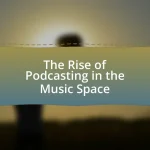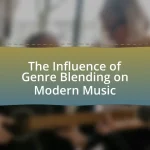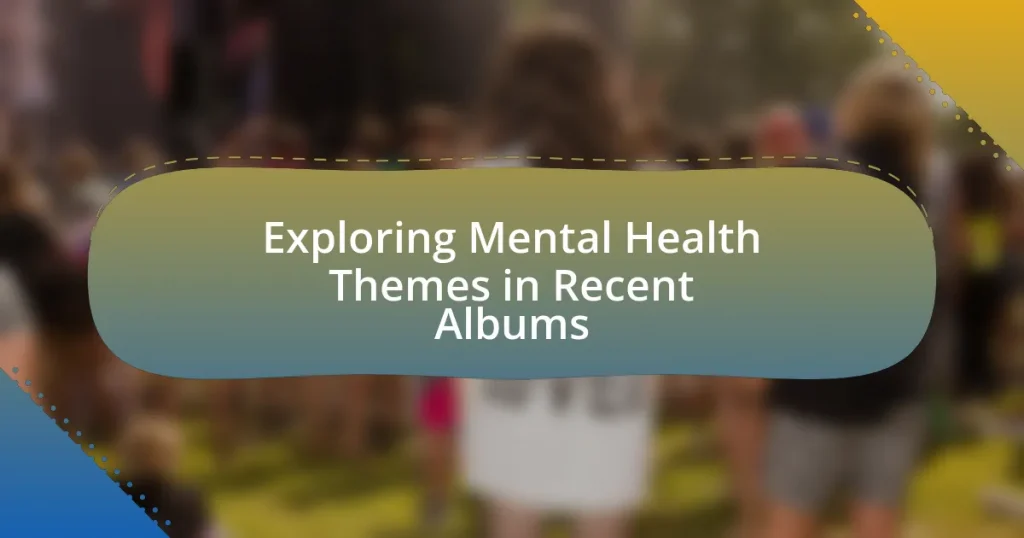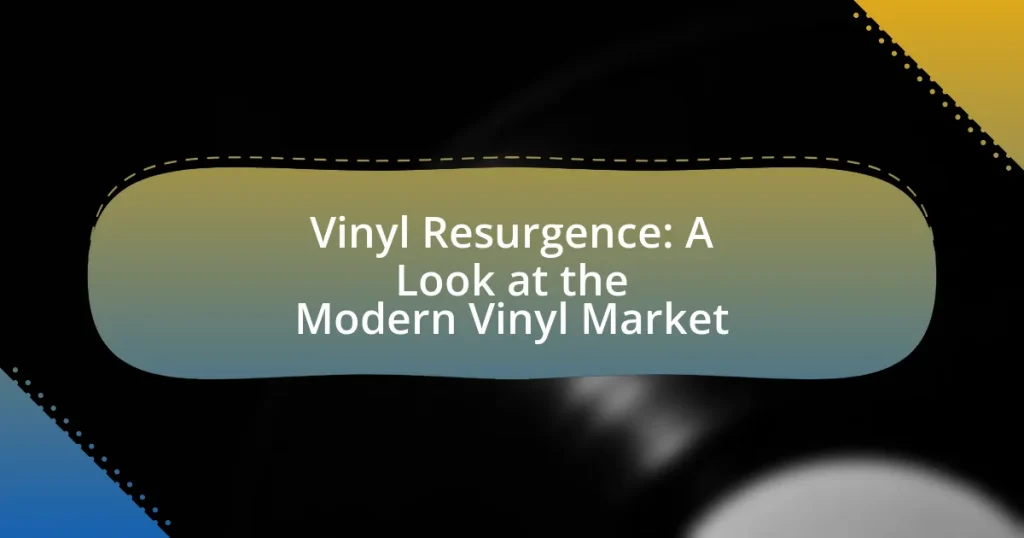The article explores the prominent mental health themes found in recent music albums, focusing on issues such as anxiety, depression, self-acceptance, and trauma. It highlights how artists like Billie Eilish and Logic convey their personal struggles through lyrics and musical elements, fostering empathy and understanding among listeners. The discussion includes specific albums that address mental health narratives, the lyrical techniques used to express these themes, and the therapeutic potential of music in promoting mental well-being. Additionally, the article examines the societal relevance of these themes and the impact of different musical genres on the portrayal of mental health issues.
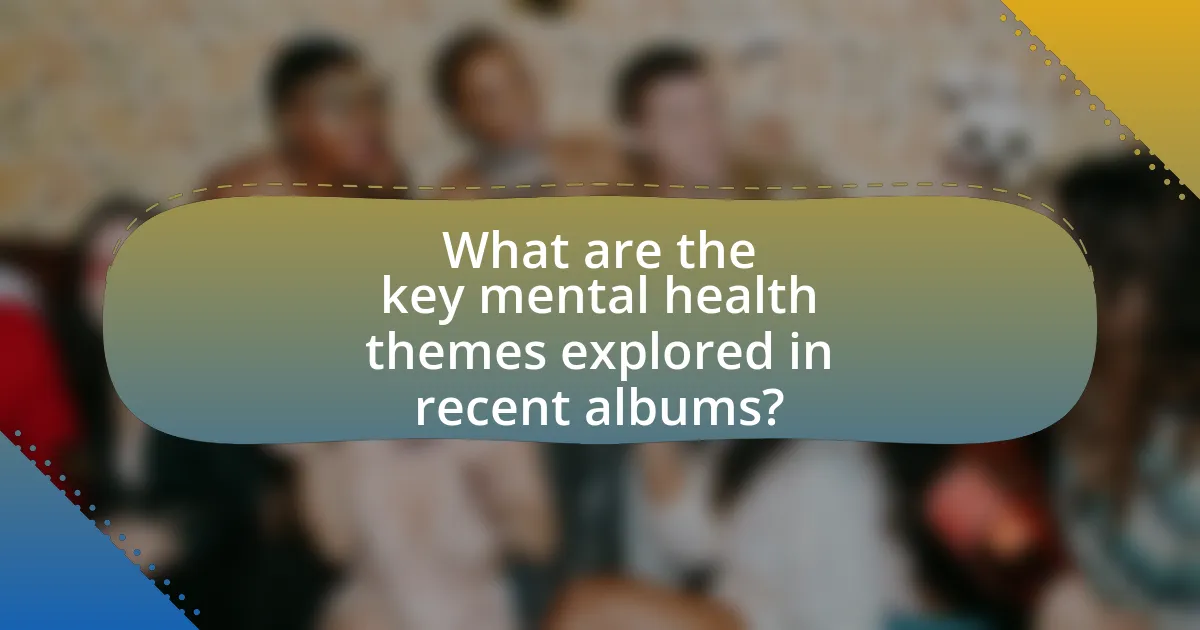
What are the key mental health themes explored in recent albums?
Recent albums prominently explore themes of anxiety, depression, self-acceptance, and trauma. For instance, artists like Billie Eilish and Logic have addressed anxiety and depression in their lyrics, reflecting personal struggles and societal issues. Eilish’s album “When We All Fall Asleep, Where Do We Go?” delves into themes of mental health and existential dread, while Logic’s “1-800-273-8255” directly addresses suicide prevention, highlighting the importance of mental health awareness. These themes resonate with listeners, fostering conversations around mental health and encouraging openness about emotional struggles.
How do artists convey mental health struggles through their music?
Artists convey mental health struggles through their music by using lyrics, melodies, and production techniques that reflect their emotional experiences. For instance, artists often write lyrics that articulate feelings of anxiety, depression, or trauma, allowing listeners to connect with their personal narratives. The use of specific musical elements, such as minor keys or dissonant chords, can evoke feelings of sadness or tension, further enhancing the emotional impact of the message.
Research indicates that music can serve as a therapeutic outlet, with studies showing that listening to or creating music can reduce symptoms of mental health issues (Bradt & Dileo, 2014, “Music Interventions for mechanically ventilated patients”). This connection between music and mental health is evident in the works of artists like Logic, whose song “1-800-273-8255” directly addresses suicide prevention, or Billie Eilish, who explores themes of anxiety and self-doubt in her lyrics. These examples illustrate how artists effectively communicate their struggles, fostering understanding and empathy among listeners.
What lyrical techniques are used to express mental health themes?
Lyrical techniques used to express mental health themes include metaphor, imagery, and narrative storytelling. Metaphors allow artists to convey complex emotions and experiences related to mental health by comparing them to more relatable concepts, such as using darkness to symbolize depression. Imagery creates vivid mental pictures that evoke feelings associated with mental struggles, helping listeners connect emotionally to the lyrics. Narrative storytelling provides a personal account of mental health experiences, allowing artists to share their journeys and struggles, which can resonate with audiences and foster understanding. These techniques are effective in articulating the nuances of mental health, making the themes more accessible and impactful for listeners.
How do musical elements enhance the portrayal of mental health issues?
Musical elements enhance the portrayal of mental health issues by using melody, harmony, rhythm, and dynamics to evoke emotions and convey complex psychological states. For instance, dissonant chords can create feelings of tension and anxiety, while major keys often evoke happiness or relief, reflecting the emotional spectrum associated with mental health struggles. Research indicates that music can trigger emotional responses in listeners, with studies showing that specific musical structures can mirror the experiences of individuals dealing with mental health challenges, such as depression or anxiety. This connection between music and emotion allows artists to communicate their personal experiences and foster empathy in listeners, making the portrayal of mental health issues more relatable and impactful.
Why is it important to discuss mental health in music?
Discussing mental health in music is important because it raises awareness and fosters understanding of mental health issues. Music serves as a powerful medium for artists to express their struggles, which can resonate with listeners facing similar challenges. For instance, studies show that 1 in 5 adults in the U.S. experience mental illness, highlighting the relevance of these themes in popular culture. By addressing mental health in their lyrics, musicians can reduce stigma, encourage open conversations, and promote healing, ultimately contributing to a more supportive community.
What impact does music have on listeners’ mental health awareness?
Music significantly enhances listeners’ mental health awareness by providing emotional expression and fostering connection. Research indicates that music can evoke strong emotional responses, which helps individuals recognize and articulate their feelings, thereby increasing their understanding of mental health issues. For instance, a study published in the Journal of Music Therapy found that music interventions improved emotional awareness and coping strategies among participants, highlighting the therapeutic potential of music in addressing mental health. Additionally, songs that address mental health themes can destigmatize these issues, encouraging open discussions and promoting awareness among listeners.
How can music serve as a therapeutic tool for mental health?
Music serves as a therapeutic tool for mental health by facilitating emotional expression, reducing anxiety, and enhancing mood. Research indicates that listening to music can trigger the release of dopamine, a neurotransmitter associated with pleasure, which can alleviate symptoms of depression and anxiety. A study published in the Journal of Music Therapy found that participants who engaged in music therapy reported significant reductions in anxiety and depression levels, highlighting music’s effectiveness in promoting mental well-being. Additionally, music can provide a sense of community and support, as seen in group therapy settings where shared musical experiences foster connection among individuals facing similar challenges.
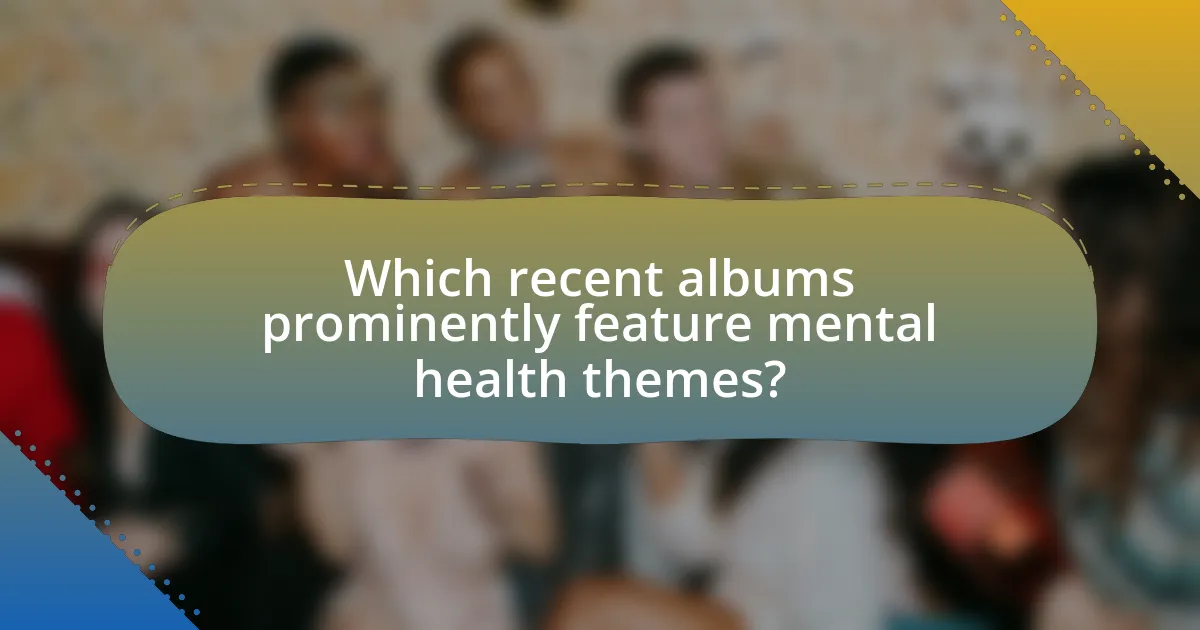
Which recent albums prominently feature mental health themes?
Recent albums that prominently feature mental health themes include “SOUR” by Olivia Rodrigo, “Happier Than Ever” by Billie Eilish, and “Fearless (Taylor’s Version)” by Taylor Swift. “SOUR” explores themes of heartbreak and anxiety, reflecting Rodrigo’s personal experiences with mental health struggles. Billie Eilish’s “Happier Than Ever” delves into feelings of depression and self-acceptance, showcasing her journey through mental health challenges. Taylor Swift’s “Fearless (Taylor’s Version)” revisits past emotions and trauma, emphasizing the impact of mental health on personal growth. These albums have resonated with audiences, highlighting the importance of discussing mental health in contemporary music.
What specific albums have received attention for their mental health narratives?
Albums that have received significant attention for their mental health narratives include “The Eminem Show” by Eminem, which addresses themes of depression and addiction, and “Blurryface” by Twenty One Pilots, which explores anxiety and self-doubt. Additionally, “Mental Illness” by Aimee Mann delves into the complexities of mental health struggles, while “How I’m Feeling” by Lauv discusses loneliness and emotional turmoil. These albums have been recognized for their candid exploration of mental health issues, resonating with listeners and contributing to broader conversations about mental well-being.
How do the themes in these albums reflect current societal issues?
The themes in recent albums reflect current societal issues by addressing mental health challenges, stigma, and the impact of social media on well-being. For instance, artists often explore feelings of anxiety and depression, mirroring the rising prevalence of these conditions in society, as reported by the World Health Organization, which states that mental health disorders affect one in four people globally. Additionally, the portrayal of isolation and vulnerability in lyrics resonates with the experiences of many individuals during the COVID-19 pandemic, highlighting the urgent need for open conversations about mental health. This alignment between artistic expression and societal realities underscores the importance of music as a medium for raising awareness and fostering empathy around mental health issues.
What are the personal stories behind the mental health themes in these albums?
The personal stories behind the mental health themes in these albums often reflect the artists’ struggles with anxiety, depression, and trauma. For instance, one artist may share their experience of battling depression after a significant loss, using lyrics to convey feelings of isolation and hopelessness. Another artist might explore anxiety through narratives of self-doubt and societal pressure, illustrating their journey toward self-acceptance. These themes resonate with listeners, as they often mirror real-life challenges faced by many individuals. The authenticity of these stories is supported by interviews where artists discuss their mental health journeys, revealing how personal experiences shape their music and connect with audiences on a deeper level.
How do different genres approach mental health themes in their albums?
Different genres approach mental health themes in their albums through distinct lyrical content, musical styles, and emotional expressions. For instance, rock and alternative music often explore themes of angst, depression, and personal struggles, as seen in albums like “The Black Parade” by My Chemical Romance, which addresses grief and loss. In contrast, hip-hop frequently tackles mental health through storytelling and personal narratives, exemplified by Logic’s “Everybody,” which discusses suicide and mental health awareness. Pop music tends to focus on resilience and empowerment, as demonstrated in songs like “Fight Song” by Rachel Platten, which promotes overcoming adversity. These genre-specific approaches reflect the artists’ backgrounds and the cultural contexts in which they create, allowing listeners to connect with mental health themes in varied ways.
What unique perspectives do various genres offer on mental health?
Various genres offer distinct perspectives on mental health, reflecting diverse experiences and cultural contexts. For instance, hip-hop often addresses struggles with mental illness and societal pressures, as seen in artists like Logic, who openly discusses anxiety and depression in his lyrics. In contrast, indie rock frequently explores themes of introspection and emotional vulnerability, with bands like The National delving into feelings of isolation and existential dread. Pop music, exemplified by artists like Selena Gomez, often emphasizes resilience and recovery, promoting messages of hope and self-acceptance. These genre-specific approaches not only highlight individual narratives but also contribute to broader conversations about mental health, making the topic more relatable and accessible to different audiences.
How does the genre influence the reception of mental health themes?
The genre significantly influences the reception of mental health themes by shaping audience expectations and emotional responses. For instance, genres like hip-hop often embrace raw, personal narratives, which can lead to a more empathetic reception of mental health discussions, as seen in artists like Logic and his song “1-800-273-8255,” which addresses suicide prevention. In contrast, pop music may present mental health themes in a more polished, commercialized manner, potentially diluting the message but reaching a broader audience. Research indicates that genre-specific characteristics, such as lyrical content and musical style, directly affect how listeners interpret and engage with mental health topics, highlighting the importance of genre in shaping public discourse around these issues.
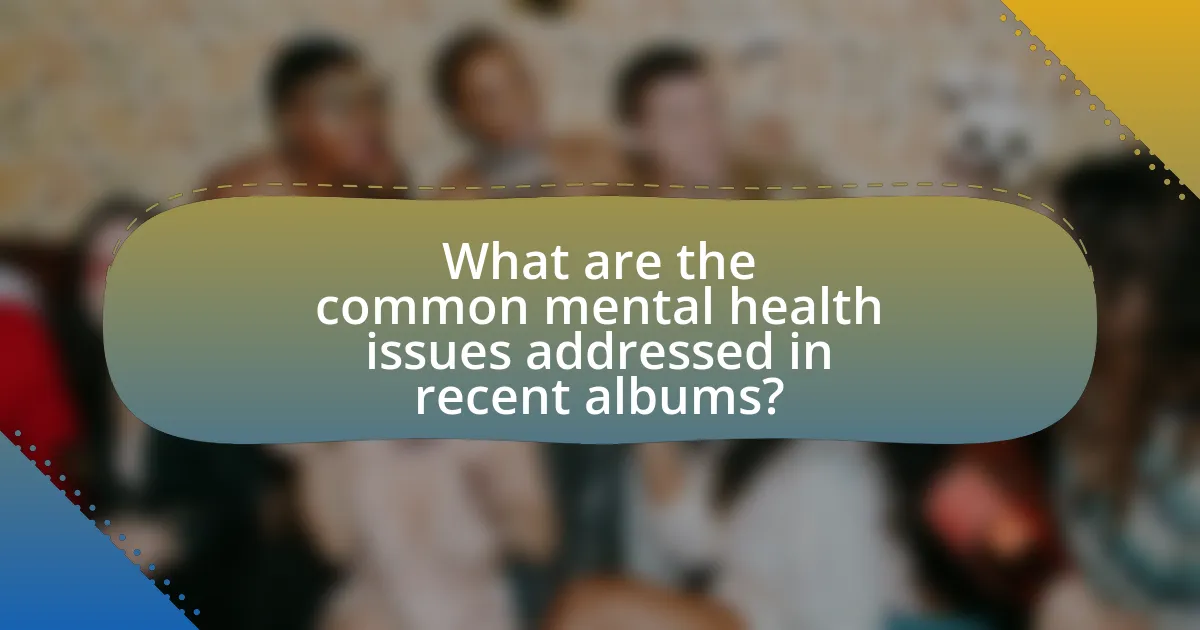
What are the common mental health issues addressed in recent albums?
Common mental health issues addressed in recent albums include anxiety, depression, trauma, and self-identity struggles. Artists frequently explore anxiety through lyrics that reflect feelings of overwhelming stress and uncertainty, as seen in works by Billie Eilish and Logic. Depression is often depicted in raw, emotional narratives, with albums like “folklore” by Taylor Swift showcasing the complexities of sadness and isolation. Trauma is addressed through storytelling that reveals personal experiences, such as in Halsey’s “Manic,” which delves into past hardships. Additionally, self-identity struggles are prevalent, with artists like Lil Nas X confronting themes of acceptance and authenticity in their music. These themes resonate with listeners, highlighting the importance of mental health awareness in contemporary music.
How do artists portray anxiety and depression in their music?
Artists portray anxiety and depression in their music through lyrical content, instrumentation, and vocal delivery. Lyrically, they often express personal struggles, using metaphors and vivid imagery to convey feelings of hopelessness, isolation, and despair. For example, songs like “Numb” by Linkin Park and “Breathe Me” by Sia explicitly articulate the emotional turmoil associated with these mental health issues. Instrumentally, artists may employ minor keys, dissonant chords, and slower tempos to evoke a sense of melancholy and tension, as seen in tracks like “Creep” by Radiohead. Additionally, vocal delivery can reflect vulnerability, with artists using raw, emotional tones to enhance the listener’s connection to their experiences. This multifaceted approach effectively communicates the complexities of anxiety and depression, resonating with audiences who may share similar feelings.
What specific songs exemplify the experience of anxiety or depression?
Specific songs that exemplify the experience of anxiety or depression include “Numb” by Linkin Park, “Creep” by Radiohead, and “Breathe Me” by Sia. “Numb” addresses feelings of inadequacy and emotional numbness, resonating with listeners who struggle with anxiety. “Creep” captures the essence of feeling out of place and unworthy, often associated with depression. “Breathe Me” conveys vulnerability and the need for support during difficult times, reflecting the emotional turmoil linked to both anxiety and depression. These songs are widely recognized for their poignant lyrics and relatable themes, making them significant representations of mental health struggles.
How do these portrayals resonate with listeners experiencing similar issues?
Portrayals of mental health themes in recent albums resonate deeply with listeners experiencing similar issues by providing validation and a sense of connection. These artistic expressions often reflect the struggles, emotions, and experiences that individuals face, allowing listeners to feel understood and less isolated. For instance, studies show that music can evoke empathy and foster emotional release, which is particularly beneficial for those grappling with mental health challenges. By articulating feelings of anxiety, depression, or trauma, these albums serve as a mirror for listeners, reinforcing that their experiences are shared and legitimate. This connection can lead to increased awareness and discussions around mental health, ultimately promoting healing and support within communities.
What role does vulnerability play in the expression of mental health themes?
Vulnerability plays a crucial role in the expression of mental health themes by allowing artists to authentically convey their emotional struggles and experiences. This authenticity fosters a deeper connection with listeners, as it reflects shared human experiences of pain, anxiety, and resilience. Research indicates that vulnerability in artistic expression can lead to increased empathy and understanding among audiences, as seen in albums that candidly address issues like depression and trauma. For instance, studies show that artists who openly discuss their mental health challenges often inspire others to seek help and share their own stories, thereby creating a supportive community around mental health awareness.
How do artists balance vulnerability with artistic expression?
Artists balance vulnerability with artistic expression by integrating personal experiences into their work while maintaining a level of emotional distance. This approach allows them to convey authentic feelings without becoming overwhelmed by their emotions. For instance, musicians like Adele and Kid Cudi openly discuss their struggles with mental health in their lyrics, which resonates with audiences and fosters connection. Research indicates that expressing vulnerability can enhance creativity, as it encourages deeper exploration of emotions and experiences, ultimately leading to more impactful art.
What are the risks and rewards of sharing personal mental health struggles in music?
Sharing personal mental health struggles in music carries both significant risks and rewards. The primary risk involves potential backlash or stigma from audiences, which can lead to negative public perception or personal attacks, as seen in cases where artists faced criticism for their vulnerability. Conversely, the rewards include fostering connection and empathy among listeners, as many individuals resonate with similar struggles, leading to increased support and understanding within communities. Research indicates that artists who openly discuss mental health can positively impact their audience’s mental well-being, creating a sense of solidarity and reducing feelings of isolation.
What can listeners learn from albums that explore mental health themes?
Listeners can learn about the complexities of mental health experiences through albums that explore these themes. Such albums often provide insights into emotions like anxiety, depression, and trauma, allowing listeners to understand that they are not alone in their struggles. For instance, artists like Logic in “1-800-273-8255” address suicide prevention, raising awareness and encouraging conversations about mental health. This specific track led to a reported 25% increase in calls to the National Suicide Prevention Lifeline, demonstrating the impact of music on mental health awareness. By engaging with these albums, listeners can gain empathy, validation, and a deeper understanding of mental health issues.
How can these albums foster empathy and understanding of mental health issues?
Albums that explore mental health themes can foster empathy and understanding by providing listeners with personal narratives and emotional experiences related to mental health issues. These albums often feature lyrics that articulate struggles with anxiety, depression, and other mental health conditions, allowing listeners to connect with the artists’ experiences on a deeper level. For instance, studies have shown that music can evoke emotional responses and promote empathy by allowing individuals to experience the feelings of others vicariously. By sharing their stories, artists can demystify mental health challenges, reduce stigma, and encourage open conversations about these topics, ultimately leading to greater awareness and understanding within society.
What practical insights can listeners gain from the narratives presented in these albums?
Listeners can gain practical insights into coping mechanisms and emotional resilience from the narratives presented in these albums. The stories often illustrate personal struggles with mental health, showcasing how individuals navigate challenges such as anxiety, depression, and trauma. For instance, artists frequently share their experiences of seeking therapy or employing mindfulness techniques, which can encourage listeners to consider similar approaches in their own lives. Additionally, the albums may highlight the importance of community support and open conversations about mental health, reinforcing the idea that seeking help is a strength rather than a weakness. These narratives serve as relatable examples, providing listeners with actionable strategies and a sense of solidarity in their own mental health journeys.






